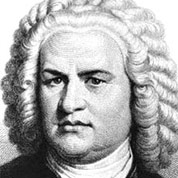BWV1006a Minuet I-Lute Suite No.4 in E Major by JSBach
 Johann Sebastian Bach was a German composer, organist, harpsichordist, violist, and violinist whose sacred and secular works for choir, orchestra, and solo instruments drew together the strands of the Baroque period and brought it to its ultimate maturity. |



Notes
This minuet is taken from Bachs Lute Suite No.4 in E Major which is a transcription from Bach’s Partita III for the solo violin. BWV1006a is a graceful and formal french dance in vogue during the middle 1600’s to 1800 – when it was replaced by the waltz. By 1700, the minuet became part of the standard Baroque suite. All minuets have 3 beats per measure, often with 2 or 3 changes of harmony in each measure.
BWV1006a- Lute Suite No.4 Minuet I in E
Time Signature 3/4. 34 Bars. Moderate to Brisk. AABB
This minuet in E Major consists mostly of 2 or 3 notes played together (chords in harmony). BWV1006a is technically demanding for both hands so start slow. Notes of the chords must be played simutaneously therefore land the chords in time by thinking ahead. It may feel awkward at first but keep practising and you WILL memorize the chords shape automatically.
Counterpoint. You will need to hold the bass note for the entire measure thru out the song. In BWV1006a, you have 2 voices: the bass-root note (voice 1) and the melody (voice 2). Counterpoint (interplay of 2 or more voices) won’t work if the bass note is short lived or absent during the melody run. You need the bass note to be present and not fade out or expire by the end of the measure. Bar[21]-[23] proved to be a section for me I spent the most time on.
Bar[5]-[6]. The transition of one barre chord to another barred chord after a hammer on is rather difficult here. Left Fingering is important. Keep the third finger on G# (high E, 4th fret) during hammer on and keep it there to form the next barre chord. Basically use your left 3rd finger as pivot during the 2 Barre chord transition. Although both barre chords occur on the 2nd fret, I barre twice rather than hold the barre. This took some time to get used to. Practice by going back and forth between latter part of bar[5] and start of bar[6] to get familiarize with the motion.
Tricky Areas
Bar[5] Barre chord hammer on. Use third finger as pivot then switch to next barre chord…
Bar[6] …followed by rapid shift of barred chords with individual string picking
Bar[11] More chords. Pay heed to careful fingering. Think ahead
Bar[21]-[23] Trio of Barred Chords (bass should be held during the melody run)
Hear this minuet first and know it! In general for Bach I memorize (notes)-until my short term memory fails me. For pieces longer than 2 pages, I do not want to flip during play. Knowing the song by heart will give you the advantage of thinking ahead. When i say this I mean while playing a chord, think of planting the next chord (which finger to which string). Since this minuet has a lots of chords, anticipating the next step helps.
